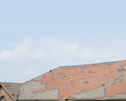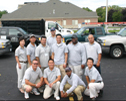In 2003, the Occupational Safety and Health Administration (OSHA) initiated the process of new rulemaking for the use of cranes and derricks in construction. A proposed rule was published in 2008, and some provisions of the final rule became effective Nov. 8, 2010. Under the rule, Subpart CC—Cranes and Derricks in Construction has been added to the construction industry regulations at 29 CFR 1926.1400-1442. The standard will be fully effective Nov. 8, 2014.
Equipment exclusions
One key element of the new standard is the scope and applicability of power-operated hoisting equipment and, importantly for roofing contractors, the specific equipment excluded from the standard's coverage.
The new subpart applies to power-operated equipment that can "hoist, lower and horizontally move a suspended load." Forklifts are excluded from the standard except when configured to a hoist by a winch or hook.
Another significant exclusion applies to articulating or knuckle-boom truck cranes (commonly used in roofing operations) when used to unload materials from the unit to the ground or deliver packaged building material onto a structure with a fork or cradle—but only if the boom truck is equipped with a functioning automatic overload protection device.
OSHA provides specific examples of packaged building materials, including plywood, roofing shingles and rolls of roofing felt. The exclusion does not apply to boom trucks used to facilitate construction activities—for example, holding material in place as a worker installs it.
Certification, qualification
Likely the most anticipated and controversial provisions in the final rule surround the new requirement for crane operator qualification or certification. In jurisdictions with crane-operator licensing laws, the new OSHA rules require crane operators to be properly licensed by those government entities. In other jurisdictions, the new crane standard requires equipment operators to be one of the following:
- Certified by an accredited crane operator testing agency by passing written and practical examinations assessing knowledge and skills in operating the specific type and capacity of equipment
- Qualified by successfully completing written and practical tests under an employer's in-house, independently audited crane-operator testing program
- Qualified by possessing a current crane operator qualification by the U.S. military
The new crane standard requires roofing contractors to ensure each person signaling an operator during specified crane operations meets certain qualification requirements, which include:
- Knowledge and understanding of the type of signals used
- Competence in applying the type of signals used
- Understanding of basic crane operations and limitations
- Knowledge of the standard's signal requirements
- Successful completion of an oral or written test and a practical test
Additionally, the new crane rule introduces the term "qualified rigger," which is defined as a person who, in possessing a recognized degree, certificate or professional standing or extensive knowledge, training and experience, has successfully demonstrated the ability to solve problems related to rigging loads lifted by cranes.
Helping you comply
The new crane standard is complex and will require significant effort to comply with its provisions. NRCA has made available a preliminary compliance package to assist members in assessing qualified riggers and training and evaluating signal persons.
Harry Dietz is NRCA's director of risk management.



